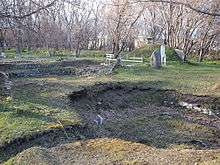Okhotsk culture
The Okhotsk culture is an archaeological coastal fishing and hunter-gatherer culture of the lands surrounding the Sea of Okhotsk (600–1000 in Hokkaido, until 1500 or 1600 in the Kuril Islands). The historical Okhotsk people were related to the Jōmon people, which are ancestral to the Ainu people. Modern Nivkh people and Itelmens among others, were found to have rather high Jōmon ancestry.[1][2] It is suggested that the bear cult, a practice shared by the Ainu and the Nivkhs, was an important element of the Okhotsk culture and may have been common in Jomon period Japan as well.[3]
| Alternative names | Mishihase (possible) |
|---|---|
| Geographical range | around the Sea of Okhotsk |
| Preceded by | Jomon culture |
| Followed by | Satsumon culture |

A distinctive trait of the Okhotsk culture was its subsistence strategy, traditionally categorised as a specialised system of marine resource gathering.[4] This is in accord with the geographic distribution of archeological sites in coastal regions and confirmed by studies of animal remains and tools, that pointed to intensive marine hunting, fishing, and gathering activities.[5] Stable nitrogen isotope studies in human remains also point to a diet with rich protein intake derived from marine organisms.[6][7][8] Collagen analysis of human bones revealed a relative contribution of marine protein in a range of 60 to 94% for individuals from Rebun Island and from 80 to 90% for individuals from eastern Hokkaido. However, there are enough evidences to suggest that the Okhotsk people's diet was much more diverse than isotopic data suggests. Their diet was probably complemented with terrestrial mammals, such as deer, foxes, rabbits, and martens. Cut marks in domesticated dog bones suggest they were also part of the diet, and remains of domestic pigs are limited to the north of Hokkaido. There is also evidence of the use of wild edible plants, including Aralia, Polygonum, Actinidia, Vitis, Sambucus, crowberry, Rubus sp., Phellodendron amurense, and Juglans. Little is known about the role of these plants in the economy or if they had dietary or ritual roles.
Kisao Ishizuki of the Sapporo University claimed that the people of the Okhotsk culture were recorded under the name Mishihase on the Japanese record Nihon Shoki,[9] while others suggest that the term Mishihase described a different group.[10]
References
- Sato, Takehiro; Amano, Tetsuya (2007). "Origins and genetic features of the Okhotsk people, revealed by ancient mitochondrial DNA analysis". Journal of Human Genetics. 52 (7): 618–27. doi:10.1007/s10038-007-0164-z. PMID 17568987.
- https://www.genetics.org/content/202/1/261
- Trekhsviatskyi, Anatolii (2007). "At the far edge of the Chinese Oikoumene: mutual relations of the indigenous population of Sakhalin with the Yuan and Ming dynasties". Journal of Asian History. 41 (2): 134–135. JSTOR 41933457.
- Hudson, Mark J. (2004-09-01). "The perverse realities of change: world system incorporation and the Okhotsk culture of Hokkaido". Journal of Anthropological Archaeology. 23 (3): 290–308. doi:10.1016/j.jaa.2004.05.002. ISSN 0278-4165.
- Leipe, Christian; Sergusheva, Elena A.; Müller, Stefanie; Spengler, Robert N.; Goslar, Tomasz; Kato, Hirofumi; Wagner, Mayke; Weber, Andrzej W.; Tarasov, Pavel E. (2017-03-29). "Barley (Hordeum vulgare) in the Okhotsk culture (5th–10th century AD) of northern Japan and the role of cultivated plants in hunter–gatherer economies". PLoS ONE. 12 (3): e0174397. doi:10.1371/journal.pone.0174397. ISSN 1932-6203. PMC 5371317. PMID 28355249.
- Aikens, C. Melvin; Rhee, Song Nai; Circum-Pacific Prehistory Conference, eds. (1992). Pacific northeast Asia in prehistory: hunter-fisher-gatherers, farmers, and sociopolitical elites. Pullman, Wash.: WSU Press. ISBN 9780874220926. OCLC 26403218.
- Yoneda, Minoru; Ono, Hiroko; Amano, Tetsuya; Ishida, Hajime; Dodo, Yukio; Honch, Noah V.; Shibata, Yasuyuki; Mukai, Hitoshi; Ohkouchi, Naohiko (2010). "Dietary Reconstruction of the Okhotsk Culture of Hokkaido, Japan, Based on Nitrogen Composition of Amino Acids: Implications for Correction of 14C Marine Reservoir Effects on Human Bones". Radiocarbon. 52 (2): 671–681. doi:10.1017/S0033822200045690. ISSN 0033-8222.
- Yoneda, Minoru; Ishida, Hajime; Naito, Yuichi I.; Tsutaya, Takumi (2014). "Carbon and nitrogen isotope analyses of human and dog diet in the Okhotsk culture: perspectives from the Moyoro site, Japan". Anthropological Science. 122 (2): 89–99. doi:10.1537/ase.140604. ISSN 0918-7960.
- "第4回 北海道と胆振地方の古代史" (in Japanese). Tomakomai Komazawa University. Retrieved February 22, 2011.
- "ウェブマガジン カムイミンタラ ~北海道の風土・文化誌 :オホーツク文化人とモヨロ貝塚 網走 流氷とともにやってきた古代民族の謎とロマンに魅せられた父子三代と研究者たち". kamuimintara.net. Retrieved 2019-05-14.
External links
- Ohyi, Haruo (1975). "The Okhotsk Culture, a Maritime Culture of the Southern Okhotsk Sea Region". In Fitzhugh, William (ed.). Prehistoric Maritime Adaptations of the Circumpolar Zone. pp. 123–58. doi:10.1515/9783110880441.123. ISBN 978-3-11-088044-1.
- Sato, Takehiro; Amano, Tetsuya; Ono, Hiroko; Ishida, Hajime; Kodera, Haruto; Matsumura, Hirofumi; Yoneda, Minoru; Masuda, Ryuichi (2007). "Origins and genetic features of the Okhotsk people, revealed by ancient mitochondrial DNA analysis". Journal of Human Genetics. 52 (7): 618–27. doi:10.1007/s10038-007-0164-z. PMID 17568987.
- Okada, Atsuko (1998). "Maritime Adaptations in Hokkaido". Arctic Anthropology. 35 (1): 340–9. JSTOR 40316474.